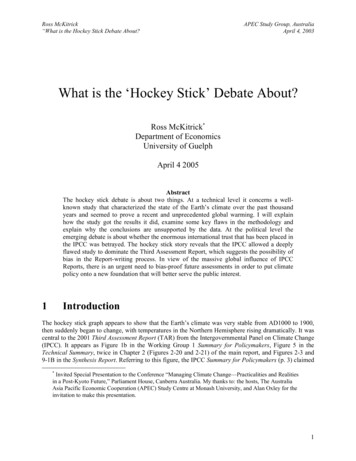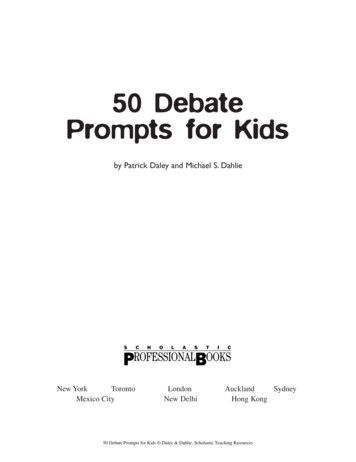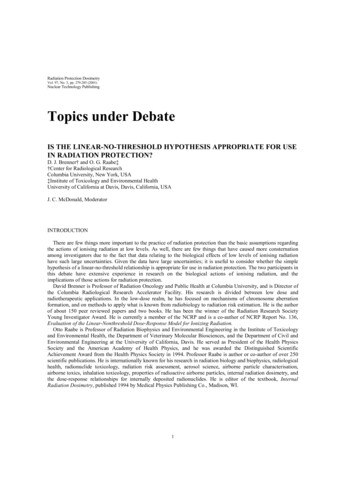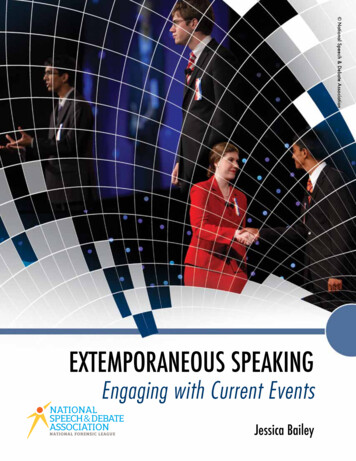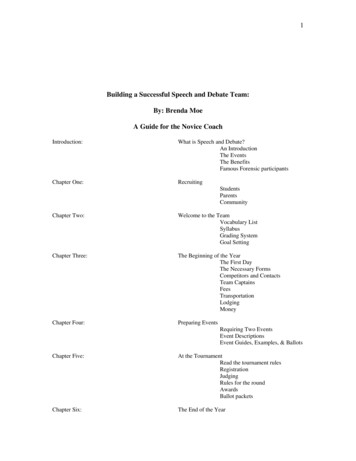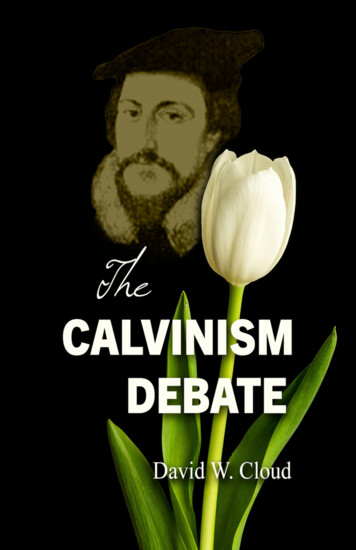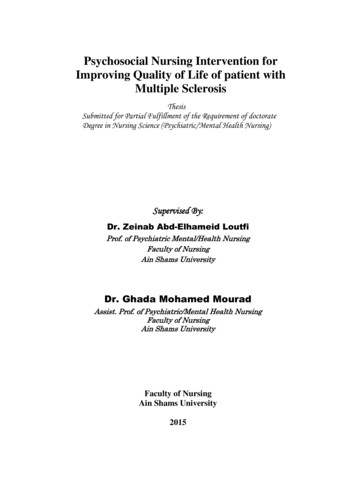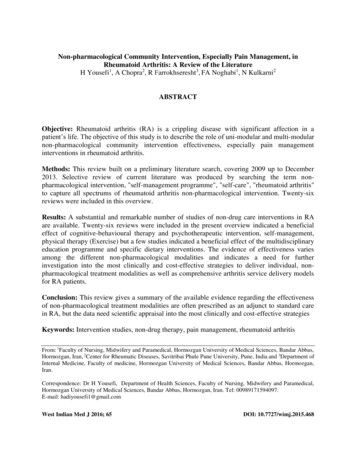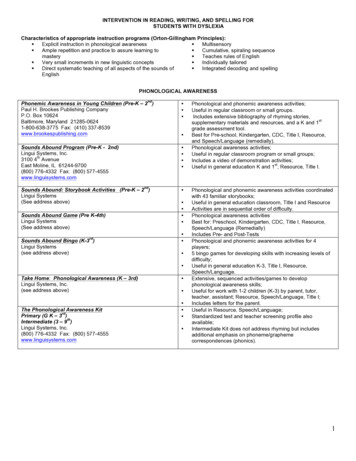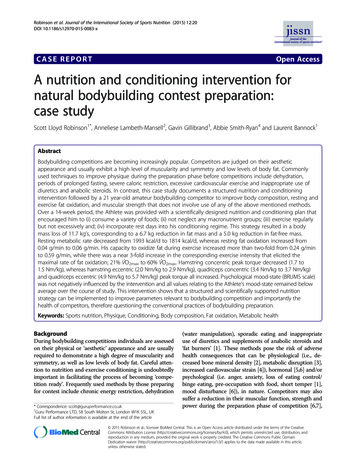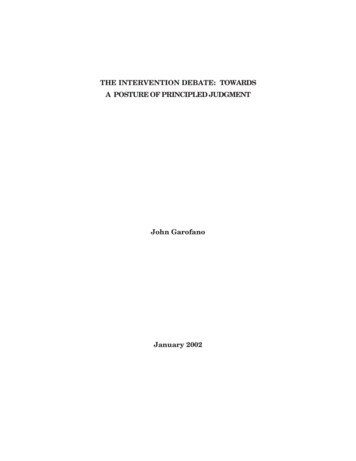
Transcription
THE INTERVENTION DEBATE: TOWARDSA POSTURE OF PRINCIPLED JUDGMENTJohn GarofanoJanuary 2002
*****The views expressed in this report are those of the author and do notnecessarily reflect the official policy or position of the Department of theArmy, the Department of Defense, or the U.S. Government. This reportis cleared for public release; distribution is unlimited.*****The author would like to thank the Smith Richardson Foundationfor its generous support; and Ivan Arreguin-Toft, David Edelstein,Steven Metz, and Douglas Stuart for comments on earlier drafts.*****Comments pertaining to this report are invited and should beforwarded to: Director, Strategic Studies Institute, U.S. Army WarCollege, 122 Forbes Ave., Carlisle, PA 17013-5244. Copies of this reportmay be obtained from the Publications Office by calling commercial(717) 245-4133, FAX (717) 245-3820, or via the Internet atRita.Rummel@carlisle.army.mil*****Most 1993, 1994, and all later Strategic Studies Institute (SSI)monographs are available on the SSI Homepage for electronicdissemination. SSI’s Homepage address is: **The Strategic Studies Institute publishes a monthly e-mailnewsletter to update the national security community on the research ofour analysts, recent and forthcoming publications, and upcomingconferences sponsored by the Institute. Each newsletter also provides astrategic commentary by one of our research analysts. If you areinterested in receiving this newsletter, please let us know by e-mail atoutreach@carlisle.army.mil or by calling (717) 245-3133.ISBN 1-58487-081-8ii
FOREWORDDeciding when and how to use force is one of the centralelements of strategy. Throughout American history, debate hasraged over whether force is appropriate only in defense of thehomeland and vital national interests or whether it should also beused to promote more expansive objectives like regional securityand stopping humanitarian disasters in regions with few tangibleU.S. interests.The 1990s showed the extremes of this issue. In the George H.Bush administration, Secretary of Defense Caspar Weinbergerand Chairman of the Joint Chiefs of Staff Colin Powell bothadvocated restrictive conditions for the use of force, with tangibleinterests at stake, clear support from the American people andCongress, and an explicit exit strategy. In the Clintonadministration, officials such as National Security AdvisorAnthony Lake and Secretary of State Madeleine Albrightsupported a more expansive use of force in places like theBalkans. Eventually the Clinton administration settled upon acomplex set of requirements that tried to bridge manyapproaches, but it, too, failed to gain wide acceptance among thepolity or the public at large. Today, the debate still rages.The author of this monograph, Dr. John Garofano, SeniorFellow at the John F. Kennedy School of Government, argues thatAmerican policymakers must take an approach based on“principled judgment” when deciding on the use of force. Heconcludes with a discussion of Army roles and requirements forfuture contingencies.The Strategic Studies Institute is pleased to offer this study tohelp Army leaders provide effective advice to nationalpolicymakers when the use of force is being considered.DOUGLAS C. LOVELACE, JR.DirectorStrategic Studies Instituteiii
BIOGRAPHICAL SKETCH OF THE AUTHORJOHN GAROFANO is Senior Fellow at the InternationalSecurity Program, Kennedy School of Government,Harvard University, while working on a book oncivil-military relations and U.S. decisions on the use offorce. His areas of publication include military intervention,ASEAN and Asian security issues, and the making of U.S.foreign policy. Dr. Garofano has taught at the U.S. ArmyWar College, Mount Holyoke and the Five Colleges, and theUniversity of Southern California, and was a member of theU.S. Army War College’s Strategic Studies Institute during1999-2000. He is a Founding Member of the Council onEmerging National Security Affairs (CENSA), a think tankdedicated coordinating the efforts of experts from all fieldsrelating to national security and to mentoring the nextgeneration of national security leaders. Dr. Garofanoreceived his Ph.D. from Cornell University.iv
SUMMARYPolitical debate over the proper guidelines for using forcehas been polarized since the end of the Cold War. Forceconservers emphasize future threats and conventionalchallenges, while proponents of the liberal use of forceconsider a wider range of national interests and acceptgreater risk regarding future challenges. Administrationshave taken various paths between these two poles. TheWeinberger Doctrine remains one of the most influentialschools of thought. A contrary school of thought, that ofintuitive intervention, was articulated by Secretaries ofState George Shultz and Madeleine Albright but provedhighly problematic. The Clinton administration settledupon a complex set of requirements that tried to bridgemany approaches, but it, too, failed to gain wide acceptanceamong the polity or the public at large.Without general political agreement upon a generalapproach to the use of force, the military services will behard put to develop the tools required when interventionoccurs. The author argues that what may be called thePowell-Bush argument is a useful starting point for forginga consensus, since it recognizes the need for flexibility,choice, and balance—in a word, judgment—when force isconsidered. After examining the advantages of this and theother postures adopted by previous administrations, theauthor makes the case for an approach of “principledjudgment.” A series of principles, or guideposts, forintervention policy are then suggested, followed by theargument for several institutional changes that shouldstrengthen the ability of diverse administrations to exercisejudgment when using force. The author concludes with adiscussion of Army roles and requirements for futurecontingencies.v
THE INTERVENTION DEBATE:TOWARDS A POSTUREOF PRINCIPLED JUDGMENTINTRODUCTIONThe Continuing Debate.Despite a decade with which to absorb and adapt to theimplications of the end of the Cold War, the United Stateshas not settled on a basic disposition towards the use offorce. A debate continues between two main camps, forceproponents and force conservers, defined by diverging viewson the costs, risks, and effectiveness of using U.S. militaryforce for traditional and emerging challenges. Realists andidealists, Democrats and Republicans can be found in eachof these two groups. The debate was temporarily submergedin the unity that emerged following the terrorist attacks ofSeptember 11, 2001. Yet by the end of that month, theadministration’s stand on the force-conserving side of thedebate was already shaping U.S. strategy by eschewingoperations that could lead to nation-building andhumanitarian operations. It is likely that the debate shallre-emerge as a central issue of contention as U.S. foreignpolicy returns to something resembling “normalcy.”The two poles in the debate may be summarized asfollows. Force proponents consider military power merelythe first among equally valid instruments of national power,suitable for shaping the security environment as well as forresponding to direct challenges to important or vital U.S.interests. These active internationalists were generallysupportive of U.S. interventions in Bosnia, Rwanda, Haiti,Kosovo, and elsewhere. They believe America has a uniquerole in history as the sole superpower, and that it must useits power to stand up for its values as well as for a broadcontinuum of national interests.1
Force conservers, on the other hand, believe that recentadministrations have wasted precious resources onidealistic and perhaps politically-driven adventures. Suchactivities, argue these critics of the frequent use of force,weaken the country’s ability to defend against the threatsthat truly matter and will inevitably arise. Whereas forceproponents stress the long-term opportunities found incrises as well as the interconnectedness of vital, important,and humanitarian interests, force conservers echoSecretary of State John Quincy Adams’ admonition thatAmerica should “not go abroad in search of monsters todestroy.” Near-term threats to interests that are vitalrather than merely important or humanitarian, andmaintenance of the nation’s military readiness andeffectiveness against the potentially serious militarychallenges, inform the position of the force conservers. Theyusually opposed U.S. intervention in situations where wehad no clear vital interest at risk.Each school holds related views on how force should beemployed once its use has been sanctioned. Activeinternationalists believe it is suitable in a variety ofsituations and may safely and rationally be meted out inmeasured doses, while force conservers prefer to use force inoverwhelming bursts. Activists have confidence thatlimited force can usefully serve diplomatic goals, butconservers doubt the utility of limited force for vaguepolitical ends.A final, critical distinction between the two schools bearson the guidelines that should inform decisions on the use offorce. Active internationalists resist laying out maps orplans that would carefully guide when force is to be used andhow. Force conservers prefer clear and strict criteria andlike to refer to the Weinberger and Powell doctrines,discussed below, as examples par excellence of guidelines forpolicy.1The oppositional nature of this debate adversely affectsU.S. foreign policy. Strategy lurches from one side to the2
other, the product of elections, temporary political clout,and the winds of executive-legislative relations. Thissatisfies neither camp; heightens rather than lowers theshrillness of the debate; sends mixed signals to allies,potential enemies, and to instigators of local violence; andplaces great strain on the most frequently used foreignpolicy instrument—the military. In addition, lack ofagreement on the purpose of military power leads to missedopportunities as well as to thinly supported operations,such as that in Somalia. When an intervention is the resultof a tenuous political compromise, strategy and resourcesfor the mission may also be compromised, potentiallyleading to unexpected casualties and rapid withdrawal.This antithetical yet unresolved debate also has seriousimplications for military innovation and adaptation.Without some clear sense of where the nation is likely tosend it, the military will resist risky, expensive, and painfulchanges in hardware, doctrine, and organization. Politicaluncertainty makes innovation a risky strategy fororganizations and for leaders of those organizations.For the Army, the strategic review undertaken by theSecretary of Defense makes a resolution of the interventiondebate even more imperative. Initial reportage indicatesthat there will be a renewed emphasis on long-rangeweapons and indeed long-range, remote approaches to theuse of force. Yet although strategic priorities are a vital andwelcome development, policymakers, as I argue below, willcontinue to be buffeted by unexpected situations andsubjected to unanticipated motivations to use force. Thisextends to the actual emplacement of troops on the ground.Basic agreement on how and when force will be used wouldassist the Army and all the services in adapting tointernational and national trends.This monograph argues that there is common groundbetween the two schools of thought, and that this area canbe expanded. The common ground is found in the realm ofjudgment—the ability to discern and weigh the myriad3
factors bearing on complex international dilemmas whilefollowing some basic guidelines. In a world where newvalues, norms, and challenges confront the remainingsuperpower, no escape from judgment can legitimately besought in a clear and fixed blueprint for action, in a rejectionof all guidelines, or in a retreat from the gray areas of thenational interest. What will be described as thePowell-Bush argument—to be distinguished from thePowell Doctrine or other pre-set formulas—provides auseful starting point for expanding the area of agreement.Recommendations will then be made for improving thequality of this judgment in lasting ways.Though unsatisfactory to ideologues, judgment is a moreuseful construct than strict criteria and full-fledgeddoctrines. Judgment acknowledges that all use-of-forcedecisions have unique characteristics, while doctrine andnarrow criteria are static and based on questionablegeneralizations. Judgment is based on principles ofpermanent relevance, including such basic facts as thestrain that peace operations place on the military and theneed for limited force options by policymakers anddiplomats. Frequently the activist approach ignores theseconstraints. Criteria and doctrine are usually politicallyloaded and of fleeting relevance, based on prior political orideological positions; judgment acknowledges thecontinuous evolution of the international securityenvironment.Policymakers inevitably confront situations that are inmany ways new and frequently sui generis. Neitherunbridled activism nor strict criteria prepare themadequately for these tasks. Judgment allows for necessarydiscussions about the frequency with which force can beused, the matching of ends with required resources, and therisks associated with various responses, including inaction.Doctrine and strict criteria assume or posit certain valuesfor these factors and then avoid further debate, while theactivist approach pays little attention to costs.4
Presidents will enter office with various degrees ofexpertise and even interest in foreign affairs, and withadvisors and advisory systems of varying degrees ofeffectiveness. Domestic politics will always influenceforeign policy, frequently to its detriment. And as was seenmerely a decade ago but forgotten prior to September 11, thesecurity environment can change fundamentally andwithout warning. For these reasons, we should begin tothink about how to make decisions on using force regardlessof these inevitable limitations. This requires anagreed-upon posture of flexible, “principled judgment” andthe institutional support necessary for it.The dichotomy in the current debate belies fourapproaches that administrations have adopted since theVietnam war. These are described and critically assessed inPart II. In Part III, the author sets forth several principlesthat should guide future decisions on the use of force.Finally, in Part IV he discusses possible methods forinstitutionalizing better judgment in complex decisions.FOUR FRAMEWORKS AND THEIR IMPLICATIONSThe Doctrinal Approach: Weinberger and RecentEchoes.Secretary of Defense Caspar Weinberger provided thefirst well-defined programmatic description of when andhow the United States should use force in the post-Vietnamperiod. In a speech to the National Press Club on November28, 1984, he laid out six “tests” that should be met beforeU.S. forces are employed:1. vital national interests must be at stake;2. the United States and allies must be willing to commitsufficient forces to win;3. there must be clearly defined political and militaryobjectives;5
4. forces must be sized to achieve these objectives;5. there must be reasonable assurance of support by theAmerican people; and,6. the use of U.S. force must be a “last resort.”2Weinberger had two motivations for shaping the debate.First, he felt responsible for the lives of American troops,and was vehemently opposed to placing them, for example,in the “bull’s eye” of the Beirut airport. The October 23,1983, attack that killed 241 U.S. Marines in their barracksreinforced Weinberger’s belief about what happens when amilitary force is not sized to fight and win but only to act as abuffer between opposing armies. He viewed it as a misuse ofAmerican soldiers and a misunderstanding of the utility ofmilitary power.Weinberger also sought to counter what he viewed as aState Department and National Security Council (NSC) tooeager to deploy U.S. forces abroad. As he explained in hismemoirs, these two institutions believed in the“intermixture of diplomacy and the military”:Roughly translated, that meant that we should not hesitate toput a battalion or so of American forces in various places in theworld where we desired to achieve particular objectives ofstability, or changes of government, or support of governments,or whatever else. Their feeling seemed to be that an Americantroop presence would add a desirable bit of pressure andleverage to diplomatic efforts, and that we should be willing todo that freely and virtually without hesitation. The NSC staffwas even more militant, with a number of its members seemingto me, and to the Joint Chiefs, to spend most of their timethinking up ever more wild adventures for our troops. . . . TheNSC staff’s eagerness to get us into a fight somewhere—anywhere—coupled with their apparent lack of concern for thesafety of our troops and with no responsibility therefore,reminded me of the old joke, “Let’s you and him fight this out.”3Some 2 years later, Weinberger recognized that othergoals were inherent in a reasonable national securitystrategy (NSS). These included, in addition to the obvious6
vital interests of preserving the independence, institutions,and territorial integrity of the United States and its allies,the shaping of “an international order in which ourfreedoms and democratic institutions can survive andprosper.” Further, they included the promotion ofdemocratic institutions even where major reconstructionwas required, the maintenance of an open internationaleconomic system, and the creation of an alliance ofindustrial democracies joined with the United States.4 YetWeinberger and proponents of the doctrine clearly meant toexclude the frequent use of force as a preferred policyinstrument. They certainly did not consider the promotionof democracy or good behavior in small countries not vital toU.S. interests a valid reason for using America’s militarypower.In part due to the Clinton administration’s record,Weinberger’s skepticism of active interventionism has beenmirrored in more recent calls for a set of clear and restrictivecriteria.5 Henry Kissinger opposed intervention in Bosnia inthe early 1990s on the grounds that it was not a vitalsecurity interest for the United States. In his 1994 book,Diplomacy, Kissinger called for criteria in order to avoidswings towards aimless interventionism; Americans’ beliefin their exceptional role can lead to the desire to “remedyevery wrong and stabilize every dislocation.” Alluding toJohn Quincy Adams, Kissinger notes, however, that it isjust as clear that “some monsters need to be, if not slain, atleast resisted. What is most needed are criteria forselectivity.”6John Hillen claims that because it did not develop thecriteria purportedly called for by Kissinger, the Clintonadministration squandered resources on “a host of‘feel-good’ operations” such as those in Somalia, Haiti, andBosnia. Even in Europe, American policy is “determined bylocal factions in Bosnia,” with the United States “relegated.to the role of a medium-sized player in a peripheralEuropean security affair.” Hillen then asks for criteria thatmirror Weinberger’s.77
Ambassador William Abshire, Director of the Center forthe Study of the Presidency and organizer of a transitionteam report, makes a similar argument. He hails thewisdom of President Dwight Eisenhower in purportedlylaying out a clear list of strict criteria that would have beennecessary for intervention in Indochina in 1954.Ambassador Abshire and others contend that this led to thewise decision not to use force at that time, and that this is auseful model for the future.8 Others echo this generalperspective.9Assessing the Weinberger Doctrine. Despite indicationsof change, the Weinberger Doctrine retains broadlegitimacy and support in significant portions of the d
College, 122 Forbes Ave., Carlisle, PA 17013-5244. . (CENSA), a think tank . factors bearing on complex international dilemmas wh
